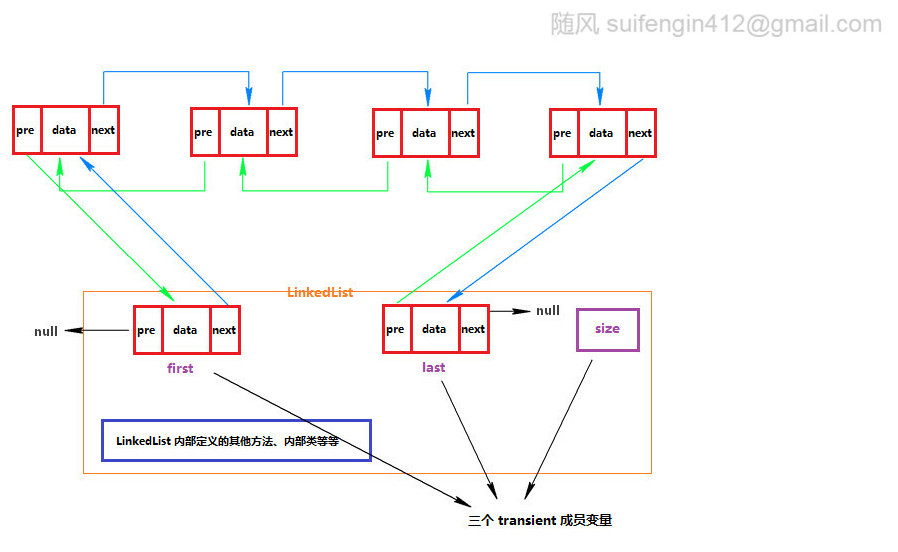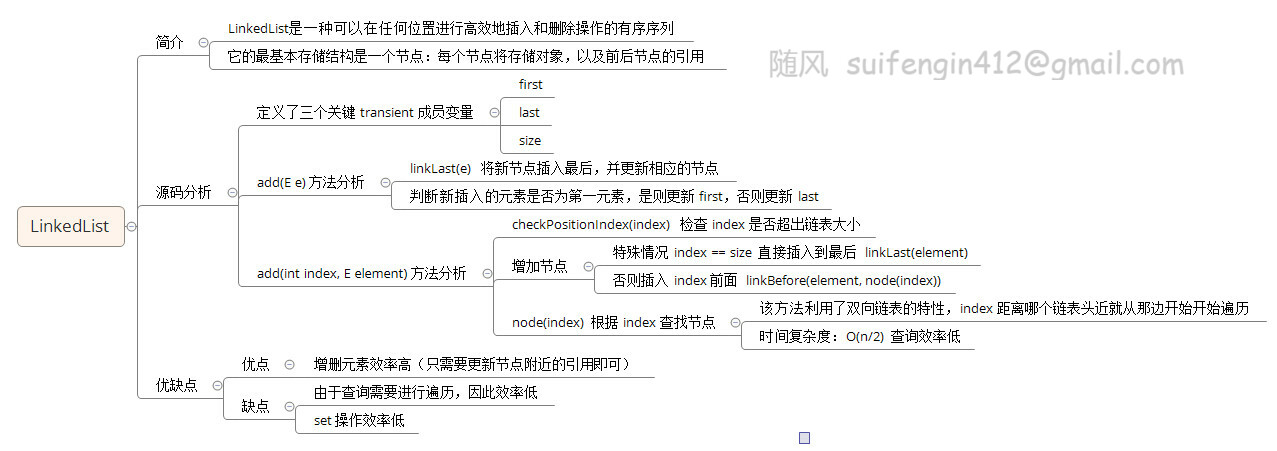Java LinkedList 详解Java 集合系列(三)—— LinkedList
那一叶随风 人气:0LinkedList
LinkedList是一种可以在任何位置进行高效地插入和删除操作的有序序列。
它的最基本存储结构是一个节点:每个节点将存储对象,以及前后节点的引用。
结构图

从上面的结构图中,我们可以了解到 ListedList 底层是基于双向链表实现的。
围起来的可以看成 LinkedList 类,它定义了三个 transient 成员变量:first、last、size。这三个变量是整个 LinkedList 类的关键点。
- 由于是双向链表(每个node都有保存前后节点的引用),因此我们不管是由 first 还是 last 节点开始迭代,都可以将整个链表的数据找出来;
- 在查询、随机插入以及set等操作都有涉及 size 判断;
- 由于 LinkedList 是双向链表,类中只存储了首尾两个节点,因此查询第n个元素都要从头遍历进行查找。
源码分析
add(E e) 源码分析
/**
* Appends the specified element to the end of this list.
*
* <p>This method is equivalent to {@link #addLast}.
*
* @param e element to be appended to this list
* @return {@code true} (as specified by {@link Collection#add})
*/
public boolean add(E e) {
linkLast(e);
return true;
}
/**
* Links e as last element.
*/
void linkLast(E e) {
final Node<E> l = last; // 将当前最后一个元素寄存在 l
final Node<E> newNode = new Node<>(l, e, null); // new 一个新节点:pre的引用为l;存储元素为e;next的引用为null
last = newNode; // 将新节点引用覆盖成员变量 last
if (l == null)
first = newNode; // 若l为null,说明之前链表为空,此时新节点为首个元素
else
l.next = newNode; // 否则,更新l的next引用
size++; // size+1
modCount++; // 非查询操作 modCount 都会 +1
}
add(int index, E element) 方法分析
/**
* Inserts the specified element at the specified position in this list.
* Shifts the element currently at that position (if any) and any
* subsequent elements to the right (adds one to their indices).
*
* @param index index at which the specified element is to be inserted
* @param element element to be inserted
* @throws IndexOutOfBoundsException {@inheritDoc}
*/
public void add(int index, E element) {
checkPositionIndex(index); // 检查 index 是否大于 size
if (index == size)
linkLast(element); // 直接在链表末尾追加
else
linkBefore(element, node(index)); // 插入index 节点前面
}
// 检查 index 是否超出范围 超出则抛出 IndexOutOfBoundsException
private void checkPositionIndex(int index) {
if (!isPositionIndex(index))
throw new IndexOutOfBoundsException(outOfBoundsMsg(index));
}
/**
* Tells if the argument is the index of a valid position for an
* iterator or an add operation.
*/
private boolean isPositionIndex(int index) {
return index >= 0 && index <= size;
}
/**
* 根据 index 查找 node
* 该方法利用了双向链表的特性,index 距离哪个链表头近就从哪边开始开始遍历
* 时间复杂度为 O(n/2);
* 当 index 接近 size 的中间值时,效率最低
* Returns the (non-null) Node at the specified element index.
*/
Node<E> node(int index) {
// assert isElementIndex(index);
if (index < (size >> 1)) { // size 右移一位(除以2)
Node<E> x = first;
for (int i = 0; i < index; i++)
x = x.next;
return x;
} else {
Node<E> x = last;
for (int i = size - 1; i > index; i--)
x = x.prev;
return x;
}
}
优缺点
优点
增删元素效率高(只需要更新节点附近的引用即可)
缺点
由于查询需要进行遍历,因此效率低
知识脑图

以上所述是小编给大家介绍的Java 集合系列(三)—— LinkedList详解整合,希望对大家有所帮助,如果大家有任何疑问请给我留言,小编会及时回复大家的。在此也非常感谢大家对网站的支持!
加载全部内容